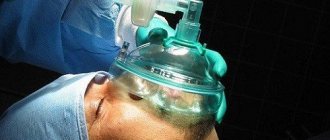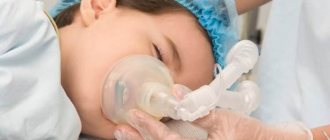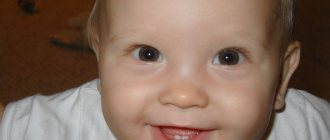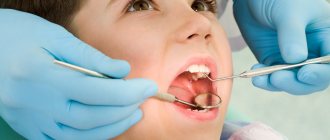When a child needs to undergo any procedure or operation under anesthesia, it is not easy for parents to make the right decision. They may have a lot of questions about everything from how the anesthesia is administered to what their baby will experience.
It should be noted that in older children and adolescents, the principles of anesthesia management differ little from those in adult patients. However, in young children, their age, anatomical and physiological characteristics, refusal to cooperate with medical personnel and fear make adjustments to the planning and management of anesthesia.
Anatomical features
A child is a growing organism and the ratio of his weight, height, and body surface changes significantly from birth. A newborn's weight is approximately 1/21 that of an adult. The most constant quantity in a child should be considered the body surface.
The proportions of a child's body are very different from those of an adult: a large head and a short neck (often the chin reaches the second intercostal space), a small chest, small limbs with poorly developed veins.
The central nervous system develops only with age. Myelination in newborns is not complete: sensory nerve fibers are myelinated and myelination of motor fibers is not completed. The spinal cord of a newborn reaches the third lumbar vertebra and only by the 2nd year of life it occupies a position corresponding to the position in adults (first lumbar vertebra), which must be taken into account during a spinal puncture.
Differences in the respiratory system are especially important: the upper respiratory tract of children is narrow. Their free patency is easily disrupted by abundant secretion of saliva, a large tongue, hypertrophied tonsils or adenoid tissue. Intubation is more difficult than in adults, since the glottis in children is located obliquely posteriorly. Immediately under the vocal cords they have a pronounced narrowing in the area of the cricoid cartilage. The mucous membrane lining the pharynx in children is prone to the development of edema due to injury or overhydration.
A child's chest is a classic example of “underdevelopment”: it is small, the sternum is soft, and the ribs are horizontal. This makes it impossible to expand the chest when breathing in the lateral and anteroposterior direction. Its volume increases during inhalation only due to the movements of the diaphragm. Movement of the diaphragm is limited due to the relatively large abdomen, which is typical even for healthy children. The respiratory muscles are poorly developed.
In children under 3 years of age, the bronchi extend at the same angle from the trachea (55°), so during intubation the tube can easily pass into the right and left bronchus. As in adults, dead space is approximately 2.5 ml per 1 kg of weight.
The child’s cardiovascular system, which functioned even in the prenatal period, has large reserves. There are no degenerative processes in the heart muscle that are often observed in adults. The functions of the cardiovascular system, impaired for any reason, quickly return to normal after the factor that caused the changes is eliminated.
Heart rate, systolic and diastolic blood pressure are very variable and differ not only at different ages, but also among children of the same age groups within a very wide range.
Blood volume in children exceeds blood volume in adults in relation to body weight - respectively 84 ml/kg in children and 80 ml/kg in adults.
The liver and kidneys finish developing after the baby is born. However, liver functions even in newborns are highly developed. Kidney function in young children is insufficient. The child is practically on the verge of “renal failure”, therefore, due to various pathological conditions, children very quickly develop dehydration and, conversely, overhydration. This makes us prefer the oral route of replacing water losses and use intravenous infusions with great caution.
Despite the relatively large size of the adrenal glands, the production of glucocorticoids in young children is insignificant. During the first 2 weeks, the child's body's protective reaction is based on glucocorticoids received from the mother. Subsequently, the response of the adrenal cortex to injury only gradually approaches that of an adult. The adrenal medulla in newborns secretes only norepinephrine.
Features of anesthesia in children
Features of the use of vasoconstrictors during anesthesia in children
In children under 5 years of age, a vasoconstrictor is not added to the anesthetic solution, because At this age, the tone of the sympathetic nervous system predominates, as a result of which adrenaline can cause increased heart rate, increased blood pressure, and heart rhythm disturbances. Under the influence of adrenaline, a sharp narrowing of the blood vessels in the abdominal cavity and skin is possible, which causes trembling, severe pallor, sticky cold sweat, and fainting. For children over 5 years old, an adrenaline solution is added at a dilution of 1:100,000 (1 drop per 10 ml of anesthetic solution, but no more than 5 drops for the entire amount of solution if it is administered simultaneously). Dosing should be carried out taking into account the body weight and age of the child.
At the same time, the vasoconstrictors themselves can cause the development of a toxic reaction, the characteristic signs of which are anxiety, tachycardia, hypertension, tremor, and headache. Adverse reactions that occur in response to the administration of vasoconstrictors in dental practice are most often associated with technical errors, exceeding the concentration of the injected solution, and repeated introduction of a vasoconstrictor with a local anesthetic into the vascular bed. In this regard, the main preventive measure is the use of standard ampoule solutions, in which the concentration of vasoconstrictors is in strict accordance with the standard.
Recommendations for local injection anesthesia in children
1. The child should be distracted during the injection.
2. Superficial anesthesia is required for the mucosal area.
3. The child should be explained that the pain from the injection occurs due to the pressure of the anesthetic solution on the oral tissue.
4. During injection anesthesia, the doctor must maintain contact with the child, monitor the color of the skin, pulse and breathing.
5. The total dose of anesthetic in children should always be less than in adults.
6. The best time to treat children is in the morning, as overtired children are difficult to persuade and do not make contact with the doctor.
In young children there is only a very small amount of loose tissue in the groove between the alveolar and palatine processes of the maxilla along the palatine neurovascular bundle. There is no fiber in the anterior part of the palate from the level of the incisive foramen, so it is almost impossible to inject an anesthetic under the mucosa, with the exception of the area of the incisive papilla, which is the most reflexogenic zone.
Conduction anesthesia on the upper jaw in children is practically not used for tooth extraction, because The cortical plate on the upper jaw in childhood is very thin, due to which the anesthetic easily diffuses through it, which ensures a good anesthetic effect. Most often, conduction anesthesia in childhood during tooth extraction is used to anesthetize the removal of molars (temporary and permanent) and premolars in the lower jaw.
A special feature of administering conduction anesthesia in a child is that it does not require precise placement of the end of the injection needle to the hole from which the neurovascular bundle emerges, because the abundance of fiber in the pterygomandibular space ensures good diffusion of the anesthetic solution to the nerve trunks.
Location of the mandibular foramen
in children varies depending on age:
1. From 9 months. up to 1.5 years - 5 mm below the apex of the alveolar process.
2. At 3.5–4 years - 1 mm below the chewing surface of the teeth.
3. At 6–9 years old - 6 mm above the chewing surface of the teeth.
4. By the age of 12, due to the predominant increase in the size of the alveolar process, the mandibular foramen “descends” to 3 mm above the chewing surface of the lower molars. The hole diameter increases from 3.3 mm to 4.5 mm.
Summarizing the above, we can conclude that in children under 5 years of age, the injection zone is located just below the chewing surface of the lower jaw teeth, and in children over 5 years of age, it is 3–5 mm above the chewing surface of the teeth.
Chin hole
in young children it is located in the area of the temporary canines, and at 4–6 years of age it is located near the apices of the roots of the second temporary molars.
Greater palatine foramen
in children it is located at the level of the distal surface of the crown V êV, and subsequently it seems to shift posteriorly and is located sequentially at the level of the distal surface of first the first permanent, then the second permanent molar
At the incisive foramen
, taking into account the reflexogenicity of the zone, an injection is made not in the center of the incisive papilla, but on the side at its base, followed by moving the syringe to the middle position. Advancement of the syringe deeper into the incisive canal by more than 5 mm is unacceptable due to the possible penetration of the needle into the nasal cavity.
Infraorbital foramen
located under the apices of the roots of the first temporary molars.
Features of pain management in old age
In elderly people, local anesthesia has a number of features due to age-related changes in the body. In elderly and senile patients, drugs are absorbed more slowly than in young patients. Therefore, it is recommended to first administer about half the dose, and then gradually increase it, guided by the rule: it is easier and safer to administer an additional dose if necessary than to cope with an overdose of the drug.
Elderly people are more sensitive to local anesthesia; they often experience intoxication, collapse, decreased blood pressure, and hypertensive crisis. Therefore, the dose of the anesthetic should be less than usual (it is more advisable to use amide anesthetics), and the anesthetic should be administered very slowly.
The choice of pain relief method should be based on a thorough analysis of the patient’s general condition, taking into account the scope of the intervention. Gerontodental patients react acutely to any injury, so it is advisable to apply topical anesthesia to the injection site.
Infiltration anesthesia is performed according to the generally accepted method. The anesthetic solution should be administered more slowly so as not to damage the sclerotic walls of the vessels. At the age of over 70 years, vascular damage is sharply expressed (thickening of the walls, sclerosis, sharp narrowing of the lumen of blood vessels up to complete obliteration). In parallel with this, arteriovenous anastomoses like closing arteries are rapidly developing. Due to the increasing difficulty in the movement of blood through the veins, the latter, to facilitate venous circulation, increase in size and their number increases. Sometimes, in place of several veins, entire plexuses are formed and anatomical prerequisites appear for the occurrence of hematomas when the vessels are injured by an injection needle.
Since in elderly and senile people the outer cortical plates of the jaws are denser, the bone canaliculi are narrowed, and the bone is sclerotic, the penetration of the anesthetic to the nerve endings is difficult. In this regard, infiltration anesthesia in this contingent is not effective enough and it is preferable to use conduction anesthesia.
One of the difficulties of anesthesia in elderly and senile patients is the reduction or complete absence of landmarks on the jaws with pronounced atrophy. In these cases, you should pay attention to the width of the lower jaw branch and the degree of its atrophy. In some cases, the wall thickness is determined from an x-ray. In patients without teeth, it is recommended to perform anesthesia using extraoral methods.
When tuberal anesthesia is carried out intra- and extraorally for a toothless upper jaw, the main landmark is the zygomaticalveolar ridge. You need to inject into its back surface and move the needle strictly along the bone 2–2.5 cm posteriorly, upward and inward from the injection site. The anesthetic solution should be released before administration. The advantage of extraoral anesthesia over intraoral anesthesia is that with this method the needle can be directed almost perpendicular to the sagittal plane, which avoids injury to blood vessels and the formation of hematomas.
Since in elderly patients, due to pronounced atrophic processes and a poorly developed fat pad of the cheek, the zygomaticalveolar ridge is easily palpable using the extraoral method, it is not difficult to perform extraoral anesthesia. And yet, due to the proximity of the pterygoid venous plexus to the tubercle of the upper jaw, there is a danger of its damage, especially in the elderly. The wound is accompanied by hemorrhage with the formation of hematomas, which can become infected and suppurate. This is especially dangerous due to the presence of a close connection with the cavernous sinus of the dura mater.
To anesthetize the area at the infraorbital foramen, it is better to perform anesthesia extraorally, since there are no intraoral landmarks (teeth) on the jaws. Failure of the needle to enter the hole can be explained by the atypical direction of the canal and anomalies in the number of holes.
In older people who use removable dentures, due to the influence of plastics and the pressure of the denture, the color of the mucous membrane of the hard palate is also dark red. In such cases, when determining the boundary of the hard and soft palate, line A serves as a guide.
In case of atrophy of the incisive papilla, during incisive anesthesia, the injection is made 0.5 cm distal to the alveolar eminence along the midline, which can be determined by the median suture of the palate.
Difficulties in performing mandibular anesthesia in people without teeth are associated with atrophy of the alveolar process, pterygomaxillary folds, retromolar fossa, anterior edge of the internal oblique line and hypertrophy of the tongue. Lingula, sulcus mylohyoideus and f. mandibulae form a functionally unified whole. The effect is achieved when the solution penetrates above the lingula and lateral to the ligamentum shenomandibulare. With the mouth wide open, the pterygomandibular fold can serve as a guide. If you mentally divide it in half and inject it in the middle, then by pointing the syringe from the opposite side (level of the 5th tooth), you can hit the bone with the needle above f. mandibulae by 1cm (the syringe should be in a horizontal position). However, sometimes even with perfectly performed mandibular anesthesia, complete anesthesia does not occur. To achieve it, you should not only release the anesthetic solution as the needle advances, but also advance it a sufficient distance (4–5 cm) and pass through the interpterygoid fascia. Then the anesthetic solution will equally wash the inferior alveolar and lingual nerves.
When performing mandibular anesthesia according to Bershe-Dubov, it is necessary to take into account the thickness of the subcutaneous base and immerse the needle to a depth of 2–2.5 cm. This type of anesthesia is used to relieve trismus of the masticatory muscles, eliminate dislocation of the temporomandibular joint, and anesthetize the mandibular nerve. It must be remembered that in old people, due to the absence of teeth or due to their pathological wear, the bite is reduced, as a result of which, when the mouth is closed, there is no gap between the lower edge of the zygomatic arch and the notch of the lower jaw branch. In this case, the needle cannot pass through the notch of the branch, because it rests on the branch of the lower jaw. Therefore, it is necessary to ask the patient to open his mouth slightly and only then give the injection. If the injection is given and... If the needle rests on the bone, then you should remove it to the subcutaneous base, ask the patient to open his mouth slightly, and then continue advancing the needle.
Carrying out mental anesthesia is not difficult, but you need to remember that due to atrophy of the alveolar process, the mental foramen seems to move towards the socket.
The use of anesthetics with vasoconstrictors in old age is limited, which is associated with the high prevalence of general somatic diseases, especially the cardiovascular system.
Features of pediatric anesthesia
The exact age at which a child begins to respond psychologically to anesthesia and surgery is unknown. It can be assumed that mental perceptions appear very early; in any case, it cannot be ruled out that factors such as surgery without anesthesia and inhalation of ether vapor have a negative impact on the central nervous system of the narcotized person.
At the age of 2-3 years, children react violently to all the unpleasant moments of anesthesia and surgery, and it is extremely difficult to establish psychological contact with them. At this age, gentle methods of induction of anesthesia are especially indicated - euthanasia using a toy mask, rectal basic anesthesia.
Excessive mental reactions gradually decrease to normal with age; A 5-year-old child can already be brought into the anesthesia room awake, and he can actively participate in the induction of anesthesia: hold the mask with his hands (self-anesthesia), blow into the anesthesia mask (exhalation will be followed by an active deep breath).
The anatomical and physiological characteristics of the respiratory system determine changes in pulmonary ventilation during anesthesia and surgery in children: the slightest increase in dead space and an increase in breathing resistance due to the apparatus quickly cause a sharp disturbance in alveolar ventilation if the child breathes on his own.
When screaming, straining, after the administration of atropine, the heart rate can reach 170-190 per minute. Sinus arrhythmia is often observed in children, but gross arrhythmias are rare. The electrocardiogram shows a predominance of the right heart, gradually giving way to a left heart.
Thermoregulation in children is most imperfect. Newborns, especially premature ones, are poikilothermic. During a 1-2 hour operation, body temperature may decrease by 2°. This can cause severe sclerema in newborns, as their subcutaneous fat has a low melting point. Even more important is the tendency toward hyperthermia observed in children. This is especially facilitated by the use of high doses of anticholinergic substances in premedication, which reduce evaporative heat loss.
Oxygen consumption is especially high: it reaches 7 ml per 1 kg of weight in children versus 4 ml per 1 kg in adults. Therefore, any hypoxia can cause severe changes in the body, which forces the use of gas-narcotic mixtures with a high oxygen content in children.
Preparing a child for surgery
It consists of psychological, sanitary-preventive and medicinal preparation. A visit to the child by an anesthesiologist on the eve of surgery or at least a conversation (game) with him before anesthesia in emergency cases significantly improves the course of induction anesthesia.
The child's stomach should be empty before anesthesia, since vomiting and regurgitation are especially dangerous in children due to the narrowness of their airways and tendency to laryngospasm.
Feeding rules must be followed:
- The last feeding of infants should be no later than midnight; 4 hours before surgery, the child can be given some water;
- children over 3 years old are not allowed to eat after dinner;
- If the operation is scheduled after 12 o'clock, then at 7 o'clock in the morning you can give a light breakfast. In cases where you are not sure that the stomach is empty, you need to empty it using a tube;
- Warn the mother about the prohibition of feeding before anesthesia.
All children are given an enema the evening before surgery.
Premedication and general principles of drug dosage in children
The peculiarities of metabolism, the release of substances from the child’s body and the discrepancy between the ratios of his weight, height and body surface require a special choice of dosages of medicinal substances. It is most advisable to use the “dose factor”, which is a coefficient calculated based on the ratio of weight gain and body surface area at different ages. By multiplying the dose of medicine calculated per 1 kg of weight of an adult by the “dose factor”, you can quite accurately determine the single dose of this substance for a child.
In premedication in children, anticholinergics, analgesics, and short-acting barbiturates are most often used. Morphine is not advisable to use. due to significant side effects. In children under 6 months of age, morphine should be strictly prohibited. It is advisable to use Nembutal in children under 9 years of age per rectum, diluting the powder in 10 ml of water and administering the solution 90 minutes before the start of surgery. Anticholinergics and analgesics are administered subcutaneously 45 minutes before surgery and intramuscularly 30 minutes before surgery.
Relatively small dosages of anticholinergics are used because large doses can contribute to the development of hyperthermia due to a sharp decrease in sweating.
It is advisable to include antihistamines and ataractic drugs in premedication. Antihistamines are prescribed at the rate of 2.5 mg per year of life and administered intramuscularly 90 minutes before surgery. Meprotan (Andaxin) is administered orally in doses of 50 mg per year of life, 3 hours before surgery. If the specified dose does not give the desired effect, it is repeated an hour before anesthesia.
Features of anesthesia machines and instruments used in children
Of the semi-open systems, the Eyre system or its modifications are most often used. The system consists of a Y-shaped (in children under 1 year of age) or T-shaped connector, one end of which is connected to the endotracheal tube, and a gas-narcotic mixture is supplied to the other. When carrying out anesthesia with spontaneous breathing, hypercapnia is prevented by a high flow of the gas-narcotic mixture: in newborns - 1.5-2 l/min, in children under 1 year - 4 l/min, in 3 years - 7 l/min, in 9-year-olds - 10-12 l/min.
In newborns, the Eyre system can be used not only with an endotracheal tube, but also with a minimum size mask.
When carrying out anesthesia in a semi-open way, you can also use special valves, but in this case it is more advisable to carry out controlled ventilation, since the resistance of the valves is minimal when carrying out anesthesia using the Aira system.
Anesthesia is administered in a closed manner either using a pendulum-shaped system or using special circulation attachments. When using a pendulum-shaped system, small absorbers are used for children under 3 years of age, and medium absorbers for older children. Two identical, well-blown dust absorbers must be prepared for work. When the absorber heats up, it must be changed to avoid burns to the respiratory tract.
A feature of the circulation system used in children is that it minimizes dead space (minimum face mask, placing valves directly on the connector - tee) and provides forced ventilation of the under-mask space. For children under 6 years of age, it is advisable to use a pendulum-shaped system, and for older children, a conventional circulation system, provided that the valve boxes are in full working order and the valves are made of the lightest material.
Anesthesia instruments include a laryngoscope with blades for premature infants (length 75 mm), children under 3 years of age (length 100 mm) and older children (length 150 mm). In premature A newborns, it is more convenient to use a straight blade.
In newborns and children up to 6 months, it is convenient to use special tubes with Cole-type restrictors. Up to 7 years of age, smooth tubes are used; in older children, tubes with cuffs can be used according to indications. When choosing tubes, three sizes are prepared before intubation: a tube whose size corresponds to the child’s age, and two tubes of adjacent sizes - larger and smaller. When carrying out anesthesia by the endonasal method, prepare a smooth tube that is smaller in number than when carrying out endotracheal anesthesia, and 20% longer.
A mandatory tool when administering anesthesia to children is a stethoscope, which is fixed with an adhesive plaster in the area of the heartbeat. They monitor cardiac activity, especially during induction of anesthesia. For chest surgery, it is advisable to use an esophageal stethoscope.
When performing anesthesia in children under one year of age, a thermometer is also required, and in premature infants and newborns, a heated operating table is required. In recovery rooms, cuvettes are supplied with humidified oxygen.
The anesthesia room and wards should have toys that can be easily sanitized.
Features of anesthesia in premature infants
Anesthesia in premature babies is accompanied by numerous difficulties, which is associated with the physiological underdevelopment of such a child’s systems, poor tolerance of anesthesia drugs, as well as the severity of diseases that, as a rule, affect several organs at once. As a rule, general anesthesia is used, and the child's condition is carefully monitored. It is necessary to ensure the temperature in the operating room at 36-37 °C, avoid high oxygen concentrations, fluctuations in heart rate and blood pressure.
In rare cases, regional anesthesia is possible, but most often it is performed in combination with general anesthesia.
Taras Nevelichuk, anesthesiologist, especially for the website Mirmam.pro
Introductory anesthesia
In children under 3 months of age, induction anesthesia can be performed using the open method. The child's cry, movements of the arms and legs accelerate the onset of anesthesia. It is necessary to take measures to ensure that anesthesia is carried out in this way in a separate room (do not disturb other children who are undergoing surgery that day). Holding your breath during induction of anesthesia for 10-15 seconds dictates that you stop instilling the drug until breathing movements are restored. Otherwise, severe hypoxia may develop. The duration of the introductory period for children with this method is 10-15 minutes. It is necessary to cover the child's eyes with a protective bandage made of thin rubber and a napkin to prevent damage to the cornea.
Introductory hardware-mask anesthesia in children of these groups is carried out using nitrous oxide (with oxygen), cyclopropane (with oxygen) or a mixture of cyclopropane, oxygen and nitrous oxide (Shane-Ashman mixture), fluorothane and nitrous oxide. The dangers of induction anesthesia in this case are associated with the characteristics of the anesthetics used.
Induction of anesthesia in children older than six months is carried out using intravenous or rectal anesthesia.
Features of introductory intravenous anesthesia in young children are its rare use due to the difficulties of venipuncture and possible respiratory depression, which makes it difficult to saturate with the main anesthetic; the use of less concentrated solutions of hexenal and sodium thiopental, slow administration of drugs; stopping the administration of drugs when “floating eyeballs” appear, which indicates the onset of stage 2. Basic anesthesia is carried out by introducing narcolan or a barbiturate solution into the rectum, or by administering suppositories with barbiturates.
Thiopental sodium is used in a 5% solution at the rate of 25 mg per kg of weight. The drug is administered into the rectum using a catheter. Narcotic sleep occurs within a few minutes. Suppositories prepared from barbiturates are used in a similar dosage. When using hexenal, the dosage is increased to 40 mg/kg.
What anesthesia is used for children?
A child can use all the same pain relief methods as an adult. The choice depends on the type of procedure or operation, the age of the child, his state of health, willingness to cooperate, and psychological mood. Can be used:
- general anesthesia (inhalation or intravenous).
- regional anesthesia (epidural, spinal).
- local or infiltration anesthesia.
General inhalation anesthesia with sevoran in children
The most common method of pain relief during surgery in children is general anesthesia, which uses special drugs to put the child to sleep. One of the most commonly used agents for general anesthesia is sevoran. It is a gas that is often used to induce and maintain anesthesia in children. In addition to sevoran, the child may be administered other drugs that maintain a relaxed state of muscles (muscle relaxants) and provide adequate pain relief (narcotic analgesics).
If the child is small and afraid, he is usually given a sweet syrup to drink that contains a drug that calms and puts him to sleep while still in the ward where he is with his parents. After this, the baby is transported in a sleepy state to the operating room, where full general anesthesia is performed. In the absence of such syrup, the anesthesiologist can give an intramuscular injection of a drug that puts the child to sleep.
In addition to inhalation anesthesia with sevoran, children can undergo general anesthesia using intravenous agents.
Conduction and regional anesthesia in children
In most young children, surgery can be done safely or only under general anesthesia. The injection of a local anesthetic, which is carried out under regional anesthesia, is often painful and may frighten the child. Therefore, conduction and regional anesthesia in young children is used only in cases where general anesthesia is contraindicated. Sometimes it is carried out under the influence of sedatives so that the baby does not feel pain from the insertion of the needle.
Local infiltration anesthesia in children
For young children, while they are sleeping, surgeons often inject a local anesthetic solution into the area of the body where surgery is taking place to temporarily stop nerve impulses from the area.
Features of endotracheal anesthesia in children
Tube insertion is more difficult in children than in adults; the tube narrows the lumen of the larynx relatively more; the danger of edema is much greater than in adults; Intubation through the nose is often accompanied by bleeding; the likelihood of laryngospasm during extubation is no less great than during intubation.
Intubation is absolutely indicated in children during intrathoracic operations, in children with intestinal obstruction, during intracranial operations and during major operations with the child in the prone position. Intubation is preferred for major surgeries of the face, head, and neck; during operations in the lateral position, as well as on the upper half of the abdomen, during tonsillectomies performed under anesthesia in a sitting position, during pneumoencephalography.
Due to the high risk of complications during tracheal intubation in children, it is contraindicated for minor operations on the extremities, perineum during hernia repair and appendectomies.
Features of anesthesia for tracheal intubation
It is more appropriate to intubate under anesthesia. When using muscle relaxants, the induction technique does not differ from that used in adults, with the exception of two points: the use of predominantly inhalation induction anesthesia and large doses of muscle relaxants. Ditiline is used for this purpose at a dose of 2.5 mg per kg of child weight.
It is most advisable to intubate children in the “improved” position. After intubation, the tube is connected to the anesthesia machine and secured with an adhesive plaster or bandage. It is necessary to fix the tube, not the connector, otherwise the tube and adapter may separate and the tube may slip into the trachea.
Extubation is performed after restoration of spontaneous breathing very gently so as not to cause laryngospasm. After extubation and before the child awakens, an oral airway is inserted.
General principles of anesthesia in children
The general principles of anesthesia are the same for adults and children. Let's consider the features relating to childhood.
Preparation for anesthesia.
Preparation for anesthesia and surgery can be divided into general, psychological and medicinal (premedication).
General preparation consists of possible correction of impaired functions and rehabilitation of the child. It is important to find out the obstetric (birth trauma, encephalopathy) and family (whether relatives have intolerance to any drugs) history.
The incidence of acute respiratory diseases is determined. Planned interventions should not be carried out earlier than 3-4 weeks after respiratory tract diseases. Find out if there are any airway obstructions (adenoids, deviated nasal septum, etc.).
When examining the cardiovascular system, it is necessary to find out whether the child suffers from congenital defects.
The risk of vomiting and regurgitation in children is greater than in adults. If the operation is scheduled for the morning, the child should not have breakfast. In cases where it is carried out secondarily, the child can be given half a glass of sweet tea 3 hours before it.
The psychological preparation of the child is very important. It is necessary to win him over, explain the nature of the upcoming manipulations, and convince him that he will not be hurt.
Premedication is carried out according to the same principles and for the same purpose as in adults. The most common premedication regimens: 1) atropine (0.1 mg/kg) + promedol (0.1 mg/kg); 2) atropine (0.1 mg/kg) + ketamine (2.5 mg/kg) + droperidol (0.1 mg/kg); 3) atropine (0.1 mg/kg) + ketamine (2.5 mg/kg) + diazepam (0.2 mg/kg); 4) thalamonal (0.1 ml per year of life). The use of ketamine provides not only the effect of premedication, but also partial induction of anesthesia.
Introduction to anesthesia.
When using ketamine as premedication, induction of anesthesia is greatly simplified. A few minutes after the administration of ketamine at a dose of 5-7 mg/kg, the surgical stage of anesthesia begins.
However, one of the most common methods of inducing anesthesia is inhalation using fluorothane and nitrous oxide. If premedication is effective, then the anesthesia machine mask is gradually brought closer to the sleeping child’s face, first supplying only oxygen, then a mixture of nitrous oxide and oxygen in a ratio of 2:1, and then 3:1. After the mask is applied to the face, inhalation of fluorothane in a minimum concentration begins, gradually bringing it to 1.5-2 vol.%.
After the onset of the surgical stage of anesthesia, intravenous administration of solutions is established, muscle relaxants are administered, the trachea is intubated, etc.
Induction by intravenous administration of anesthetics can only be carried out in children with well-defined veins and psychologically prepared for this manipulation or in cases where there is access to the vascular bed. For this purpose, sodium thiopental, hexenal, sodium hydroxybutyrate, ketamine and drugs for HLA and ataralgesia are used.
The most gentle method of induction of anesthesia is rectal. To do this, a 10% sodium thiopental solution warmed to body temperature is administered in an enema at a dose of 30-40 mg/kg.
Maintaining anesthesia.
For short-term interventions, single-component inhalation anesthesia can be used. For this purpose, nitrous oxide and oxygen can be used in a ratio of 2:1 or 3:1*, fluorotane in a concentration of 1.5-2 vol%.
In similar cases, it is also possible to use single-component non-inhalation anesthesia. Barbiturates can be used in the form of a 1% solution (in older children, a 2% solution can be used) in an amount of 7-10 ml.
The endotracheal method of anesthesia is used for operations on the chest, abdominal cavities, head, neck, mouth, and in non-physiological positions (on the side, on the stomach, in the Trendelenburg position). The intubation technique in children does not differ from that in adults. In young children, cuffless tubes are used. When using muscle relaxants, it must be remembered that children are more sensitive than adults to antidepolarizing and less to depolarizing muscle relaxants.
The method of choice for operations in children may be epidural anesthesia, as an independent type of anesthesia or as a component of general anesthesia.
Providing anesthesia using muscle relaxants and controlled ventilation
This technique is the most appropriate for all major operations and absolutely mandatory for intrathoracic operations. Switching off spontaneous breathing in children is also achieved with the help of muscle relaxants. However, their use should be more careful, given the greater risk associated with tracheal intubation and the difficulty of determining the clinic of anesthesia when spontaneous external breathing is turned off.
Muscle relaxants are indicated for operations in the chest cavity, upper abdomen, and for tracheal intubation. They are also indicated for inducing apnea for a short period of time during bronchography, angiography, fracture reposition and other similar manipulations. Indications for the use of muscle relaxants in children are laryngospasm and convulsive syndrome. Tubarin (d-tubocurarine chloride) has a stronger curarizing effect in children than in adults, so it is used in lower doses. Ditilin has to be used in much larger doses.
In most cases, muscle relaxants are administered intravenously. Ditilin and pirolaxon can be used intramuscularly (bronchoscopy, reduction of fractures, control of seizures), especially in young children when the veins are poorly developed. The dose of muscle relaxants when administered intramuscularly should be tripled. It is more advisable to use muscle relaxants when used intramuscularly in combination with hyaluronidase (20-40 units).
Carrying out anesthesia with muscle relaxants in children requires continuous monitoring of the state of hemodynamics, which remains almost the only criterion for the quality of anesthesia.
Artificial ventilation should be continued until muscle tone is completely restored. Therefore, in all cases of using antidepolarizing relaxants, proserin should be administered at the end of anesthesia. The calculation is made based on the dose of an adult, taking into account the “dose factor”. As in adults, prozerin is administered after a preliminary injection of atropine against the background of restored spontaneous breathing.
Post-anesthesia period
It is advisable to awaken as early as possible, especially if continuous nursing care is not possible. The child is placed in a warm bed on his side, preventing aspiration of vomit and retraction of the tongue,
During the first hour, pulse and blood pressure are determined every 15 minutes. Then these indicators are determined every hour for 4 hours, then after 4 hours during the day. In children under one year of age, the temperature is measured every hour for 4 hours, then measurements are taken every 4 hours. This allows for timely diagnosis of hyperthermia.
After major operations, replacement of blood and water losses continues with a slow intravenous infusion of blood or 5% glucose (8-10 ml per minute).
Analgesics are used during the first 4 hours at half the dose, then during the day at a dose of 0.75 mg per year of the child’s life. After major operations and in weak children, oxygen therapy is performed. Newborns are placed in heated incubators.
Have questions or something is unclear? Ask the article editor - .
When hyperthermia develops, pyramidon is administered intramuscularly at the rate of 30-40 mg per year of life or an enema with aspirin is given - 50 mg in newborns and up to 500 mg in older children.
In case of more pronounced and persistent hyperthermia, antihistamines are additionally administered and the child is blown with cold air. Ice packs are used and antibiotics are administered. The article was prepared and edited by: surgeon I.B. Pigovich.
Video:
Healthy:
Related articles:
- Therapeutic anesthesia Usual doses of narcotic drugs (morphine and its derivatives, chloral hydrate) in the postoperative period in some cases ...
- Spinal anesthesia Spinal anesthesia (spinal anesthesia, spinal anesthesia, spinal anesthesia, spinal anesthesia, spinal anesthesia, spinal) is a type...
- In what position can anesthesiologists perform anesthesia? Before anesthesia is administered, the patient must be placed in a certain position....
- Nasopharyngeal anesthesia The nasopharyngeal method of inhalation anesthesia is carried out in cases where inhalation anesthesia is carried out using a mask or endotracheal…
- Anesthesia for caesarean section Most often, special obstetric indications for anesthesia for caesarean section dictate the need for emergency delivery (presentation…
- Anesthesia in dentistry Most surgical interventions in dentistry can be performed under local anesthesia, but there is a significant group of patients…
Anesthesia components for children
Modern anesthesia care, depending on the initial condition of the patient and the nature of the operation, includes the following components:
1.
Inhibition of mental perception or switching off consciousness. Suppression of the child’s emotional reactions before surgery is ensured by premedication or basic anesthesia. During surgery, consciousness is turned off by any inhalational or non-inhalational anesthetic, or a combination thereof. Turning off or suppressing the child’s consciousness during an operation or painful manipulation is mandatory!
2.
Providing central or peripheral analgesia (pain relief). Central analgesia is provided by blockade of the central nervous structures involved in the perception of pain. Analgesia can be achieved by administering narcotic analgesics; morphine, promedol, fentanyl; all general anesthetics also have a fairly pronounced analgesic effect. Peripheral analgesia means the shutdown of the reception and/or conduction of pain impulses along the axons of the nocisensory system by local anesthetics administered by any means. The combination of central and peripheral analgesia significantly improves the quality of general anesthesia for a child.
3.
Neurovegetative blockade. To a certain extent, neurovegetative blockade is provided by anesthetics and analgesics. It is more reliably achieved by using ganglion blockers, neuroplegs, central and peripheral anticholinergic and adrenergic agents, using local anesthesia. Drugs of these groups reduce the patient’s excessive autonomic and hormonal reactions to stress factors that arise during surgery, especially if the operation is long and traumatic.
4.
Muscle relaxation. Moderate muscle relaxation is necessary to relax the child’s muscles during almost all operations, but when the nature of the surgical intervention requires mechanical ventilation or complete relaxation of the muscles in the operation area, muscle relaxation becomes a particularly important component. A certain level of relaxation is provided by general anesthetics. Muscle relaxation directly in the surgical area can be achieved using all methods of local anesthesia (except infiltration). Total myoplegia is a mandatory requirement in thoracic surgery and when performing a number of operations. To achieve this, muscle relaxants are used - drugs that block the conduction of impulses at neuromuscular synapses.
5.
Maintaining adequate gas exchange. Disturbances in gas exchange during anesthesia and surgery depend on various reasons: the nature of the underlying disease or surgical injury, the depth of anesthesia, the accumulation of sputum in the child’s respiratory tract, an increase in the concentration of carbon dioxide in the patient-device system, the patient’s position on the operating table, and others.
Effective pulmonary ventilation is ensured if the following conditions are met:
- correct choice of spontaneous or controlled breathing of the child during surgery;
- maintaining an open airway;
- sizes of masks, endotracheal tubes, connectors, and breathing circuits selected according to age and anatomical characteristics.
The above provisions must be taken into account not only for inhalation anesthesia, but also for all other types of anesthesia.
6.
Ensuring adequate blood circulation. Children are especially sensitive to blood loss and hypovolemic conditions, since the compensatory capabilities of the pumping function of the heart relative to the capacity of their vessels are reduced. In this regard, maintaining adequate blood circulation requires careful correction of water and electrolyte disturbances and anemia before surgery. Along with this, it is necessary to adequately maintain blood volume during the operation and in the postoperative period. The volume of blood loss during most surgical interventions in children is approximately known. Most anesthesiologists in their practical work use the gravimetric method for determining blood loss, weighing the “waste” surgical material and assuming that 55-58% of its total mass is blood. The method is very simple; but very approximate. Naturally, the functional state of blood circulation is one of the criteria for the adequacy of anesthesia. In order to maintain normal levels and correct emerging hemodynamic disorders, the anesthesiologist can use not only infusion media, but also drugs that have cardio- and vasoactive effects.
7.
Maintaining adequate metabolism is ensuring the necessary energy resources of the body, protein and carbohydrate metabolism, regulation of water and electrolyte balance, CBS, diuresis and body temperature during the intraoperative period. All these issues are covered in the relevant sections.
The modern arsenal of means and methods of general and local anesthesia is quite large. In order to clearly navigate it and make the most of all its capabilities, you need a system. Based on historical experience and modern concepts about anesthetic protection of the body, we can present the following classification of types of anesthesia.










